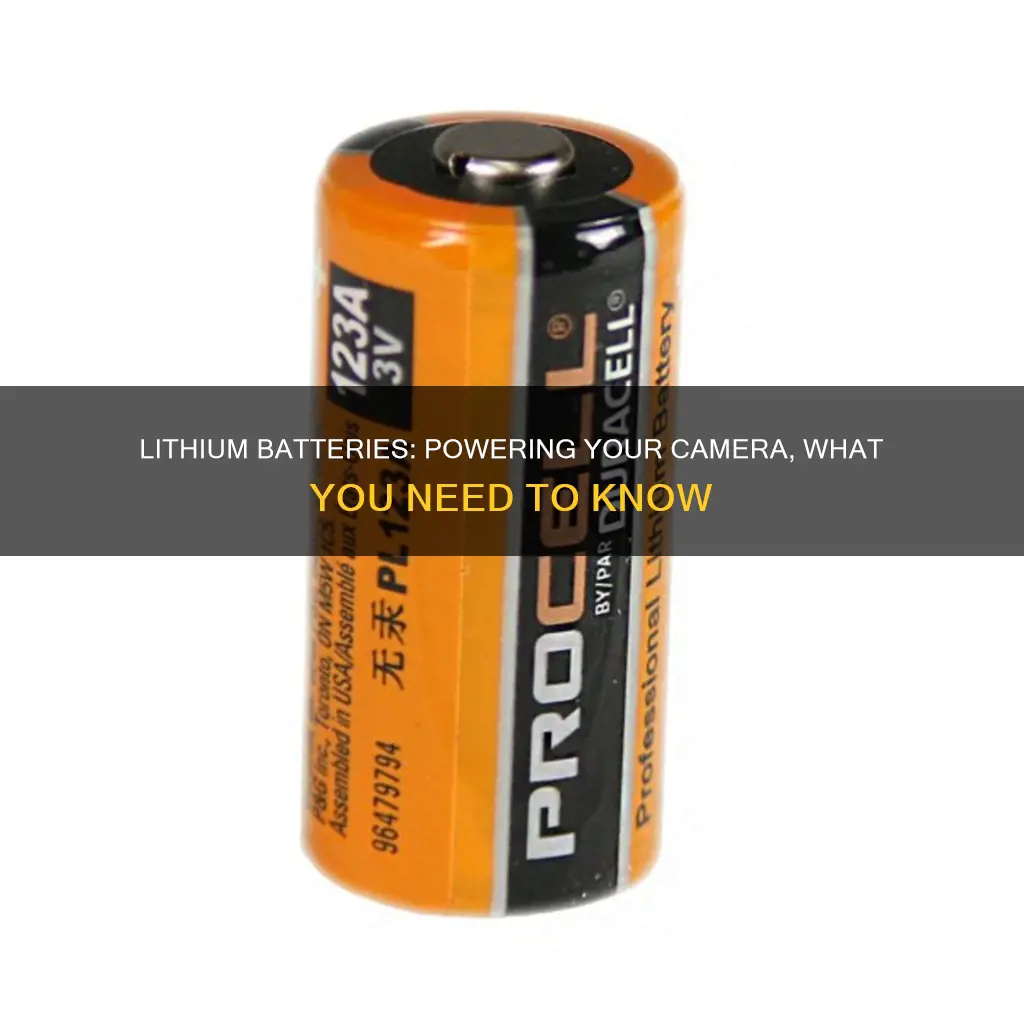
Cameras can use a variety of batteries, including lithium-ion, nickel-metal-hydride, and disposable AA and AAA batteries. Lithium-ion batteries are the most common type of battery used in digital cameras, as they are small, powerful, and rechargeable. These batteries are also found in smartphones, laptops, and tablets. While lithium-ion batteries are generally safe, aviation authorities have specific rules regarding their transport due to their potential for rapid combustion. These regulations vary depending on the battery's installation and differ across airlines. It is recommended to contact the airline directly to clarify their specific guidelines.
| Characteristics | Values |
|---|---|
| Types of batteries used in cameras | Lithium-ion, Nickel-Metal-Hydride, Disposable AA and AAA |
| Rechargeable | Yes |
| Safe to be carried on planes | Yes, if installed inside the camera |
| Safe to be carried in checked baggage | No, if loose |
| Safe to be carried in checked baggage | Yes, if installed inside the camera |
| Safety concerns | Potential for rapid combustion |
What You'll Learn

Lithium-ion batteries are commonly found in cameras
Lithium-ion batteries have become the standard choice for many camera manufacturers due to their performance and longevity. These batteries can hold a charge for a long time and can be recharged multiple times, making them a more environmentally friendly and cost-effective option than disposable batteries. Additionally, some camera manufacturers stick to a specific lithium-ion battery design across multiple generations of cameras, allowing photographers to continue using their existing batteries when they upgrade their equipment.
When travelling with lithium-ion camera batteries, it's important to be aware of aviation safety regulations. While installed lithium-ion batteries inside cameras are generally considered safe, spare batteries should be carried in carry-on baggage to ensure they can be monitored and accessed in the event of a fire. To prevent short circuits during travel, it is recommended to protect the battery terminals by using the original packaging or covering them with tape.
Lithium-ion batteries have become a popular power source not only for cameras but also for various other devices, including smartphones, laptops, electric vehicles, hearing aids, and power tools. This is due to their high energy density, rechargeability, and portability, making them a versatile and reliable choice for a wide range of applications.
Charging Your Panasonic Lumix: A Step-by-Step Guide
You may want to see also

Lithium-ion batteries are considered safe if installed inside cameras
To mitigate these risks, lithium-ion batteries used in cameras and other devices typically have multiple layers of protection. These include limiting the amount of active material, incorporating safety mechanisms within the cell, and adding an electronic protection circuit to the battery pack. These protection devices help prevent high current surges, open the electrical path in the event of excessive charge voltage, and allow for a controlled release of gas during rapid increases in cell pressure. Additionally, an external electronic protection circuit can cut off the current flow if the battery's skin temperature approaches unsafe levels.
It is worth noting that the safety of lithium-ion batteries also depends on proper handling and storage practices. For example, batteries should be stored in a well-ventilated, dry area within a specific temperature range and protected from direct sunlight, heat sources, and water.
When installed inside cameras, lithium-ion batteries are generally considered safe. However, it is important to follow the manufacturer's guidelines for charging, discharging, and storage to minimize potential risks.
Charging Your Force Camera: A Step-by-Step Guide
You may want to see also

Lithium-ion batteries are powerful yet portable
Lithium-ion batteries are also powerful. They have a high energy density, which means they can store a large amount of energy in a small space. This makes them perfect for portable devices like cameras, where weight and space are important factors. Lithium-ion batteries are also rechargeable, so you can use them again and again, making them a cost-effective and environmentally friendly choice.
When flying with lithium-ion batteries, there are some safety guidelines you need to follow. The Federal Aviation Administration (FAA) has implemented these guidelines to prevent fire-related incidents. It's important to check with the airline and the TSA for the most up-to-date information, but generally, you can carry consumer-sized lithium-ion batteries (up to 8 grams of equivalent lithium content or 100 watt-hours per battery) in your hand luggage. This covers batteries for devices like cameras, phones, and laptops.
You can also carry larger lithium-ion batteries, but there are stricter limits. For example, you may be allowed to carry up to two larger lithium-ion batteries (more than 8 grams, up to 25 grams of equivalent lithium content per battery) in your carry-on luggage. These batteries are often used for extended-life laptop batteries. It's important to note that spare lithium batteries are usually prohibited in checked baggage and should be carried in your hand luggage.
To ensure safe travel with lithium-ion batteries, it's recommended to place each battery in its own protective case, plastic bag, or package. You can also use tape to cover the battery's contacts and prevent short-circuiting. Additionally, if you're traveling with battery-powered devices, make sure they are packaged securely to prevent them from turning on accidentally during the flight.
Lithium-ion batteries are a powerful and portable energy source, making them ideal for a wide range of devices, including cameras. When traveling with these batteries, be sure to follow the safety guidelines and check for any updates from the airline and TSA.
Charging Your Polaroid Z2300: A Quick Guide
You may want to see also

Lithium-ion batteries are prone to rapid combustion
Many electronic devices, including cameras, use lithium-ion batteries. These batteries are known to be prone to rapid combustion, which can have severe consequences. This combustion can occur due to several reasons, ranging from manufacturing defects to improper usage.
Lithium-ion batteries store and release electrical energy through electrochemical reactions. These electrochemical reactions occur through a liquid medium known as an electrolyte, which consists of lithium salt and organic solvents. The organic solvents are the primary constituents responsible for fire hazards in lithium-ion batteries. The cathode, or the positively charged electrode, in the battery contains oxygen. When the battery undergoes specific stresses, such as an internal short or excessive heat, it may release oxygen from the cathode, creating an environment conducive to combustion.
Additionally, the flammable electrolyte, along with flammable and toxic gases like hydrogen, methane, carbon monoxide, and hydrofluoric acid, may escape from the battery during intense thermal incidents. These gases can further fuel fires and explosions. Lithium-ion batteries are highly sensitive to high temperatures, and their performance degrades much faster than ordinary batteries when exposed to heat. External pressure can also cause the battery to overheat and explode due to over-pressure.
To minimize the risk of combustion, it is essential to follow certain precautions. These include avoiding high temperatures, refraining from storing all items containing lithium-ion batteries together, and not overcharging the batteries. It is also important to use the correct charger intended for the battery and to charge it between 20% and 80% of its capacity.
Lithium-ion batteries have become indispensable in various technologies due to their high energy density and efficiency. However, their propensity for rapid combustion underscores the importance of adhering to safety guidelines to prevent potential mishaps.
Charging Your Hover Camera: Battery Basics
You may want to see also

Lithium-ion batteries have a limited lifespan
Yes, most cameras do have lithium-ion batteries.
Lithium-ion batteries are rechargeable batteries commonly used in consumer electronics. They are one of the most common battery types used today.
Lithium-ion batteries are used in a wide variety of products, including:
- Cell phones
- Laptops
- Tablets
- Cameras
- Power tools
- Electric vehicles
- And more
Lithium-ion batteries are popular because they have a high energy density, no memory effect, and a low self-discharge rate. However, they do have a limited lifespan.
To prolong the lifespan of a lithium-ion battery, it is recommended to avoid extreme temperatures, avoid full discharges, and avoid overcharging. It is also recommended to store lithium-ion batteries at a charge level of around 30% to 50%.
GoPro 4 Charger Cord: What Size Do You Need?
You may want to see also
Frequently asked questions
Yes, but there are some restrictions. The US Federal Aviation Administration (FAA) states that lithium-ion batteries should be kept in carry-on baggage. If you pack your camera in your checked baggage, make sure it is turned off and protected from accidental activation.
Yes, to prevent short circuits, protect the battery terminals by using the manufacturer's packaging or covering the terminals with tape. It is also recommended to place the batteries in separate bags to ensure further protection.
The FAA advises against bringing damaged lithium batteries on board an aircraft. If a battery is damaged, defective, or recalled and is likely to be a safety concern, do not carry it in your checked or carry-on baggage.
Yes, but there are limits. The FAA states that passengers can carry up to two spare larger lithium-ion batteries (101-160 Wh) with airline approval. These batteries should be carried in your carry-on baggage.







